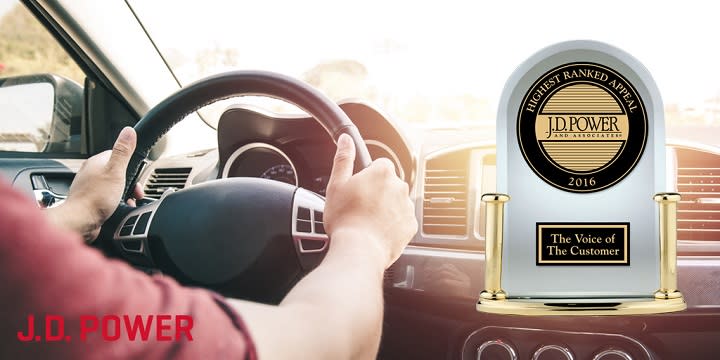2016 U.S. APEAL Study: Safety Features Score Big, Boosting New-Vehicle Appeal
New vehicles equipped with safety-oriented driver-assist features such as blind-spot monitoring and low-speed collision avoidance rate noticeably higher in owner satisfaction than vehicles without those features, according to the J.D. Power 2016 U.S. Automotive Performance, Execution and Layout (APEAL) Study.SM Overall APEAL scores are higher among the 41% of owners whose vehicles have blind-spot monitoring than among those whose vehicles lack it (821 vs. 787, respectively, on a 1,000-point scale). Similarly, APEAL scores are higher among the 30% of owners whose vehicles have collision-avoidance technology than among those whose vehicles don’t have it (828 vs. 790).

“Technology-enabled safety features help drivers feel more comfortable and confident while driving their vehicles,” said Renee Stephens, vice president of U.S. automotive quality at J.D. Power. “These features are also ‘gateway technologies’ to autonomous driving capabilities, so the continued level of consumer interest in them will be a critical metric to watch as the industry evolves toward including more automation in new vehicles.”
All-New or Redesigned Models Score Higher in APEAL
The overall industry APEAL score improves by 3 points to 801, compared with 798 in the 2015 U.S. APEAL Study. In 2016, 22 of the 30 all-new or major redesigned models included in the study score higher than their respective segment average. Over the past 10 years, newly launched models have scored an average of 29 index points higher than their segment average.
“The key to successful models is to launch with very high appeal and limit the decline that often comes in subsequent years,” said Stephens. “As automakers continue to add more content, including advanced technologies, to their vehicles, one key way to maintain appeal is to design technology that is easily upgradable and intuitive. Intuitive designs never go out of style. For example, for infotainment systems, intuitive design may mean simplification: bigger buttons, bigger screens, and menus that are laid out in a manner that is easy for the driver to understand.”
Gains in Fuel Economy Satisfaction Key to Overall Improvement
Nine of the 10 categories measured in the study improve in 2016, with Fuel Economy posting the largest gain: up 14 points year over year. Audio/Communication/Entertainment/Navigation (ACEN) and Visibility and Safety gain 6 and 4 points, respectively. However, factory-installed navigation systems remain a challenge for vehicle owners. Two of the lowest-rated vehicle attributes are related to the navigation system: Usefulness of the navigation features and Ease of using the vehicle’s navigation system. Engine/Transmission is the only category to decline (down 1 point this year). A decline in Transmission smoothness when shifting is the objection most often noted.
Even a Single Problem Can Affect Owner Advocacy and Loyalty Rates
The latest study finds that 90% of owners whose vehicles have average or above-average APEAL scores (801 or higher) and who report no problems with their vehicle in the first 90 days of ownership say they “definitely will” recommend their vehicle to others. Among owners whose vehicle has low APEAL scores (800 or lower), even when their vehicle is problem-free, advocacy drops to 64%. Among those who report one or more problems with their vehicle, only 49% say they “definitely will” recommend that vehicle to others.
Porsche Leads Brand Rankings; Volkswagen Is Highest-Ranked Non-Premium Brand
Among all brands included in the study, Porsche ranks highest in overall APEAL for a 12th consecutive year, with an index score of 877. BMW ranks second with 859; Jaguar and Mercedes-Benz tie for third at 852; and Land Rover, Lexus, and Lincoln rank fifth, tied at 843. Among Non-Premium brands, Volkswagen ranks highest with a score of 809. Following Volkswagen are Mini (808); Kia (807); Ford and Ram in a tie (803); and GMC (802).
General Motors receives six segment-level APEAL awards, followed by Hyundai Motor Company with five and BMW AG and Volkswagen AG with four each. Nissan Motor Company and Toyota Motor Corp. each have two models that rank highest in their respective segments. Daimler AG and Land Rover Jaguar Limited also receive one segment award apiece. (For a complete listing of segment award recipients, click here.)
Consumer Tips
Based on the study, J.D. Power offers the following tips:
Take notice of any dramatic increases or declines in satisfaction scores for certain models, especially those that have been redesigned. A model you may have dismissed in the past due to a shortcoming in one particular area may now meet or even exceed your expectations in that area.
Pay attention to the specific likes and dislikes of owners of new models. Perhaps you’ll pinpoint a particular feature you want on your next new vehicle.
Look for noticeable increases or declines in satisfaction scores in various categories (such as Fuel Economy or ACEN). For example, a model you may have previously dismissed due to poor fuel economy may have improved drastically in that area. Likewise, a model with a lower ACEN score may be a warning sign.
About the Study
Manufacturers and consumers use the APEAL Study to help them in design and purchase decisions. It complements the J.D. Power Initial Quality StudySM (IQS), which focuses on problems experienced by owners during the first 90 days of ownership. The 2016 U.S. APEAL Study is based on responses gathered from February through May 2016 from more than 80,000 purchasers and lessees of new 2016 model-year cars and light trucks, surveyed after 90 days of ownership.
Additional Research:
Abstract:
New vehicles equipped with safety-oriented driver-assist features such as blind-spot monitoring and low-speed collision avoidance rate noticeably higher in owner satisfaction than vehicles without those features, according to the J.D. Power 2016 U.S. Automotive Performance, Execution and Layout (APEAL) Study.
Year:
2 016
Check this if this is NOT an Articles Listing Page:
New or Used:
New
Display Article Date?:
Article Is Flipbook:
No

 Yahoo Autos
Yahoo Autos 
